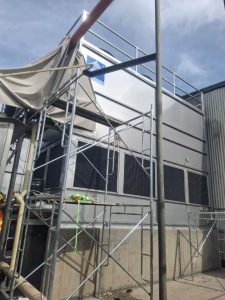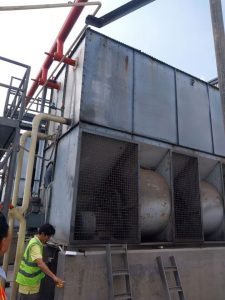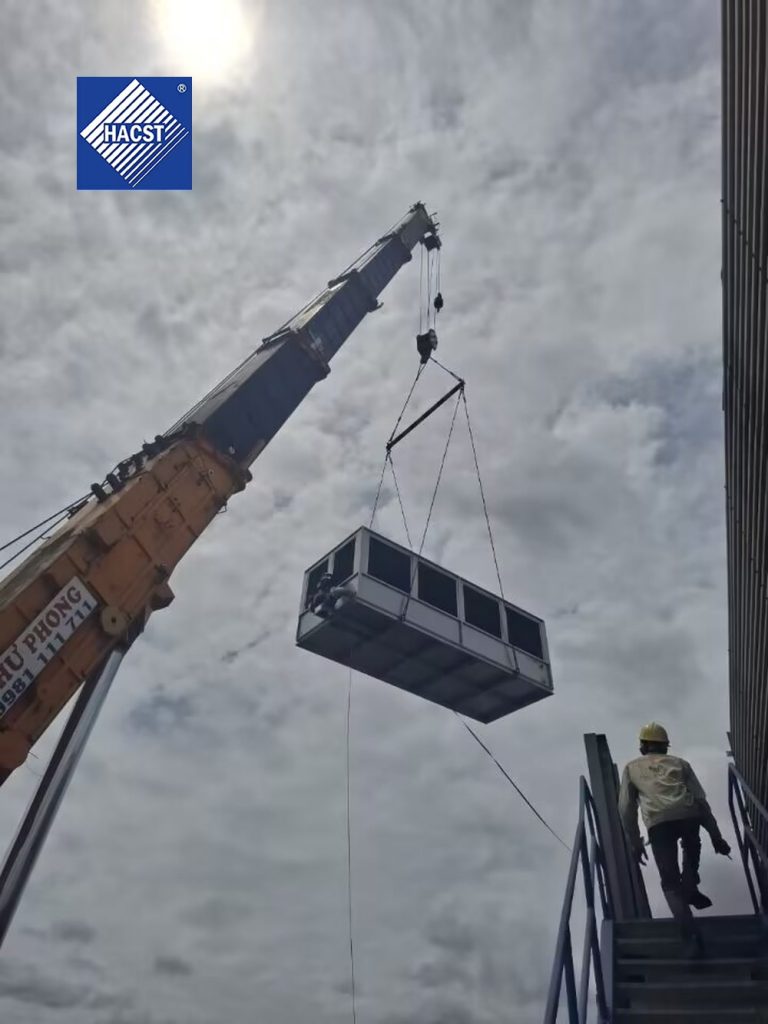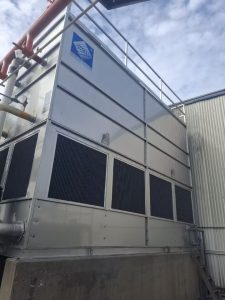Within the industrial refrigeration and process cooling industry throughout Southeast Asia, Vietnam’s harsh climatic conditions pose some unique challenges. With its high humidity, frequent seasonal rainfall, and hot summer temperatures, it demands cooling systems that are not only energy efficient but also rugged and low in maintenance. Early in 2025, one of southern Vietnam’s leading seafood processing factories faced exactly this reality when their Italian DESCA brand evaporative condenser began showing extreme signs of corrosion and thermal performance loss.
Instead of repairing an outdated system, the client decided to proceed with a full replacement project. After technical comparison and site analysis, our engineering team specified the ZNX-2010 model evaporative condenser. Not only did this project increase the plant cooling capacity, but it also provided excellent long-term value in energy savings, water conservation, and system reliability.
Project Background
Seafood processing in Vietnam relies on constant low-temperature levels to ensure freshness, hygiene, and product quality. The factory in question processes over 200 tons of frozen seafood per day, requiring constant condenser performance for ammonia-based refrigeration systems.
Their existing DESCA evaporative condenser was over 10 years old. While DESCA equipment is highly reputed in Europe, the climate and maintenance problems accelerated issues such as:
- Tube bundle corrosion from high humidity and salty air (close proximity to the coast).
- Loss of heat exchange efficiency with compressor overloading.
- Excessive noise and vibration from aging fans.
- Increased water consumption due to scaling and ineffective drift eliminators.
By the latter part of 2024, the plant had already experienced a series of shutdowns due to condenser failures, directly impacting production timetables and exports.
Why Select ZNX-2010?
The ZNX-2010 evaporative condenser was selected based on a series of technical and practical factors. The following is a comparison:
Technical Specifications of ZNX-2010:

- Capacity (kW): 1840
- Unit Type: 2010
- Fan Power (kW): 3
- Fan Capacity (m³/h): 3 × 80,000
- Water Pump Power (kW): 1
- Water Flow Rate (m³/h): 5.5
- Inlet/Outlet Pipe DN: 2 × DN100 / 2 × DN100
- Dimensions (L × W × H): 9180 × 5610 × 2200 mm
- Operating Dimensions (L × W × H): 15380 × 5610 × 4680 mm
Advantages Compared with DESCA:
 Optimized Coil Design – The ZNX series has thick-walled seamless steel tubing hot-dip galvanization, which is more anticorrosive than DESCA’s normal coating.
Optimized Coil Design – The ZNX series has thick-walled seamless steel tubing hot-dip galvanization, which is more anticorrosive than DESCA’s normal coating.
Enhanced Cooling Efficiency – At 240,000 m³/h fan capacity, the unit offers higher airflow with better distributed heat rejection.
Reduced Footprint – High capacity, even with the modular design, allows for easier transportation and installation compared to the former DESCA system.
Energy Savings – Efficient fan-pump balancing reduces overall kWh consumption by 12–15% in factory tests.
Serviceability – ZNX-2010 offers faster coil inspection and nozzle cleaning with its wide access doors and removable panels.
Installation Challenges in Vietnam
Replacement of huge industrial cooling equipment in Vietnam is never a “plug-and-play” operation. There were some site-specific challenges for the project team:

Replacement work was scheduled during the dry season to avoid untimely monsoon showers that could halt crane lifting operations. Temporary waterproof shelters were built to protect equipment from getting wet during installation.
The DESCA unit was installed in a compact space on the plant roof. Portions of the ZNX-2010 were pre-assembled on the ground by our engineers, then lifted into place by a 250-ton mobile crane during a 6-hour shutdown period.
Since pipe connections were different from those on the old DESCA design, new DN100 flanges and flexible joints were fabricated on-site to connect with the existing ammonia lines.
The city water supply in Vietnam is prone to high mineral content. To prevent scaling and achieve optimum coil life, the project also included a side-stream filtration system and chemical dosing unit.
Performance After Commissioning
The ZNX-2010 evaporative condenser was commissioned in February 2025. Performance results exceeded expectations:
- System Condensing Temperature: By 2.8–3.2°C lower than that of the DESCA unit.
- Compressor Power Consumption: By approximately 9%, with an annual electricity cost saving of approximately USD 18,000.
- Water Consumption: Optimized drift eliminators reduced visible plume and water consumption by 15%.
- Noise Level: 6 dB lower at full load, an important consideration for operators working in the area.
Zero unplanned downtime was experienced by the customer in the first 6 months of operation.
Long-Term Benefits
 Beyond the direct technical improvement, this replacement project illustrates valuable lessons for other industrial plants in Vietnam and Southeast Asia:
Beyond the direct technical improvement, this replacement project illustrates valuable lessons for other industrial plants in Vietnam and Southeast Asia:
- Local Climate Adaptation: European equipment is not always adapted to tropical, high-humidity climates. Design must accommodate local operating conditions.
- Maintenance-Friendly Design: Easy access and heavy galvanization mean less downtime and longer service life.
- Total Cost of Ownership (TCO): While the ZNX-2010 represented an upfront investment, the annual savings in energy and water will pay back the investment in just 2.5–3 years.
Conclusion
The substitution of Vietnam ZNX-2010 evaporative condenser illustrates how the substitution of an imported DESCA unit with a locally manufactured solution can achieve dramatic improvements in cooling efficiency, reliability, and sustainability.
In seafood processing, breweries, chemical plants, and cold storage, the selection of condenser model is not only a question of capacity matching but also of long-term adaptability to the local environment.
As industrial demand continues to grow in Vietnam, developments like this one set the benchmark for modern, efficient, and durable evaporative cooling systems in Southeast Asia.